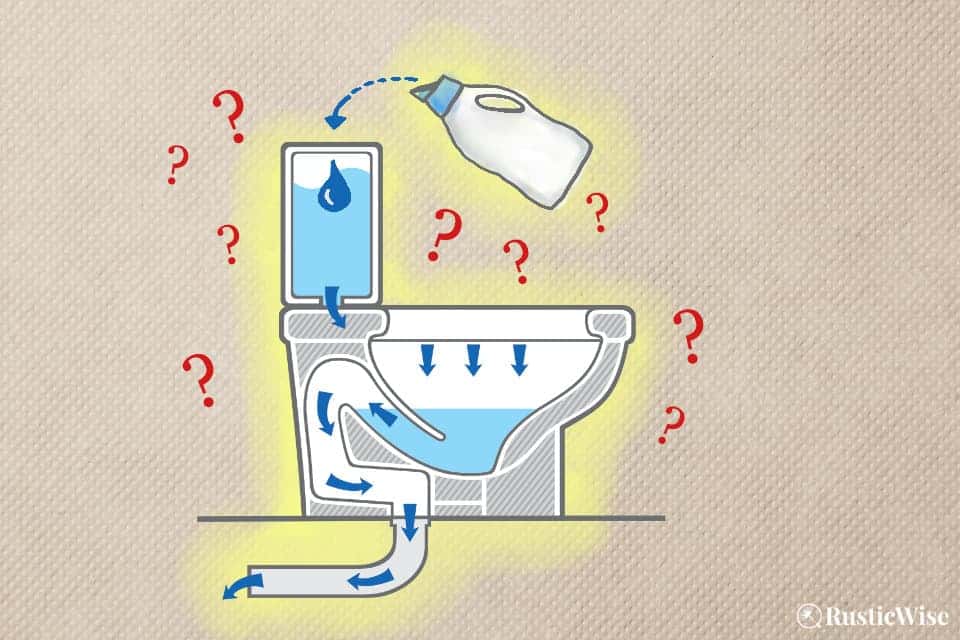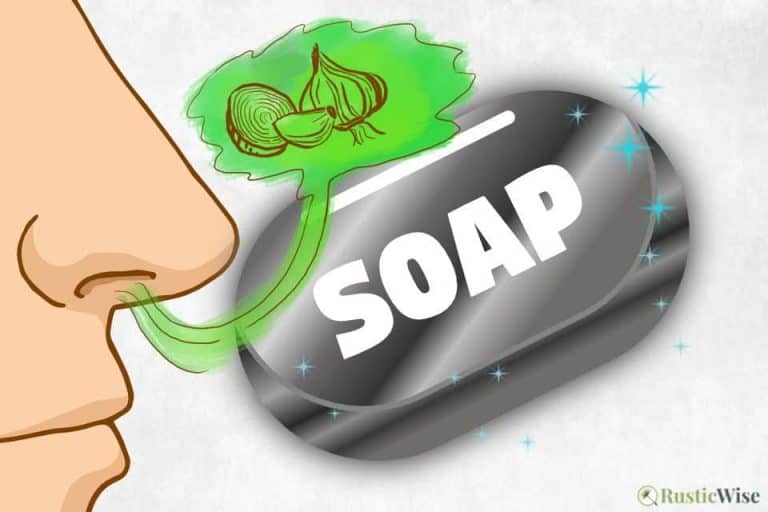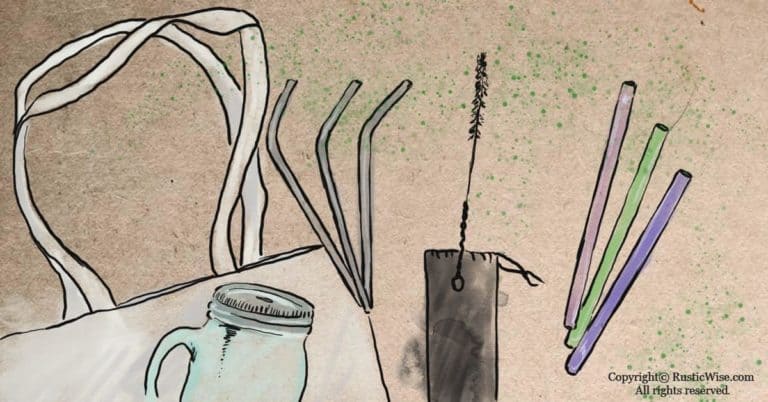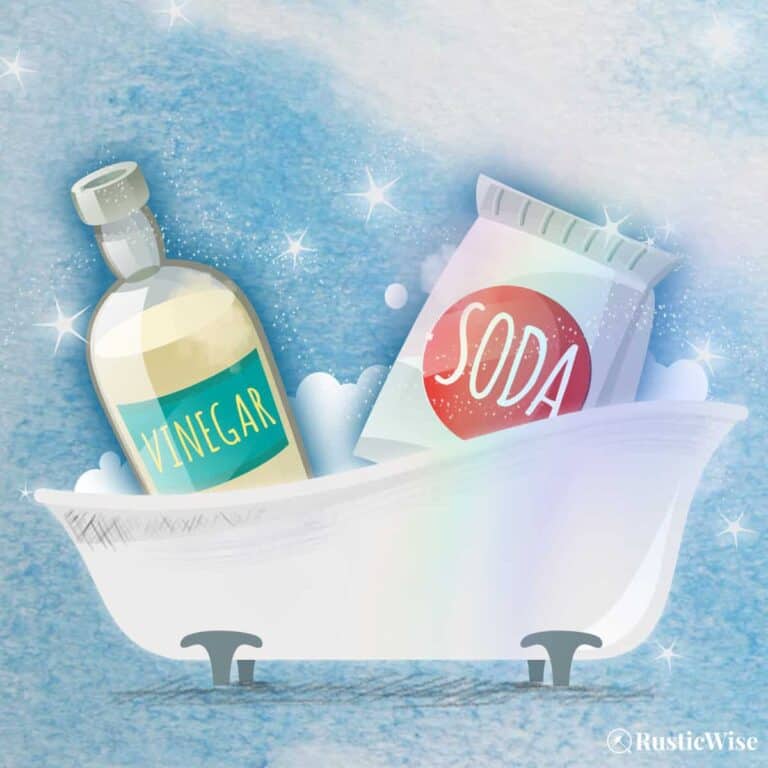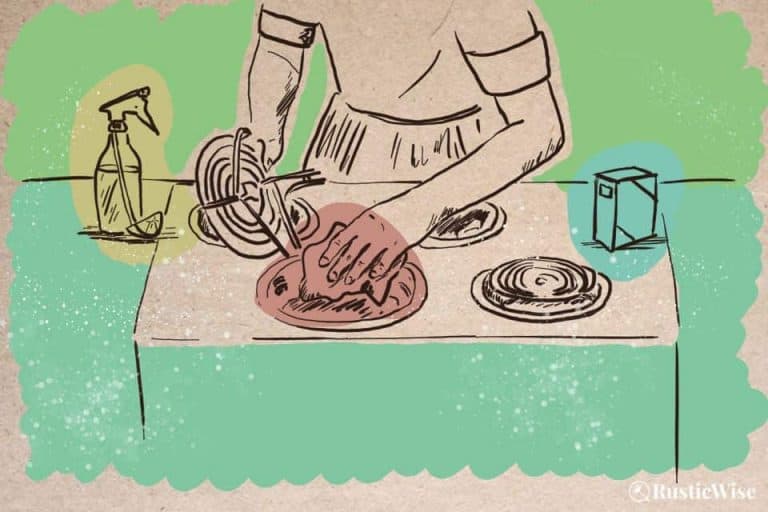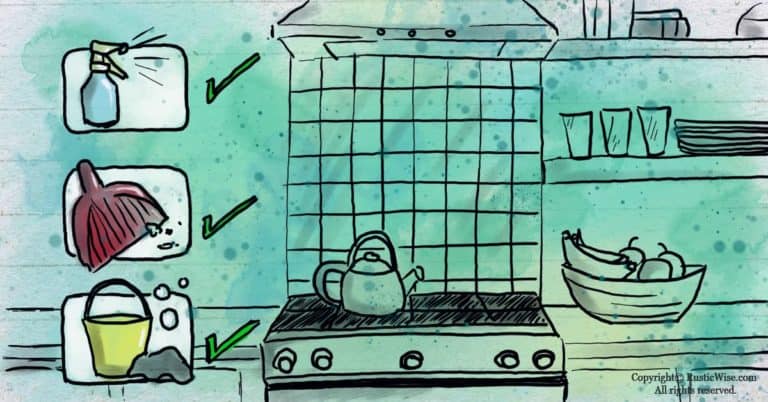3 Good Reasons You Should NOT Put Fabric Softener in Toilet Tank
The internet is awash with cleaning hacks, some of which work, and some that should be avoided at all costs.
You may have heard of the cleaning hack popularized several years ago by a company that suggested pouring fabric softener in a toilet tank. The thinking behind this hack is that this would be an easy way to keep your toilet bowl smelling fresh while keeping tough stains at bay.
I’ll cut right to the chase and tell you this is NOT a good idea for a number of reasons, mainly that it may clog your pipes and harm your septic system.
Let’s take a closer look at what’s really in fabric softener, how it can damage your plumbing, and how to truly keep your toilet smelling daisy-fresh without harmful chemicals.
Why put fabric softener in toilet tank?
Something that softens and freshens up clothes must be safe to use for a toilet, right? Not necessarily.
The company that shared this toilet tank cleaning hack suggested pouring a cup of fabric softener of your choice (such as Downy) into the toilet tank. Once the liquid settles into the bottom of the tank, you can reap the benefits of a laundry-fresh clean every time you flush.
It’s like a two-in-one cleaner and air freshener with a sweet aroma, or so the thinking goes …
While fabric softener gives your laundry a pleasant fragrance, removes static, and keep your fabrics snuggly soft, it was never designed for use in toilets.
Does fabric softener really work?
Is fabric softener all that it’s cracked up to be?
Liquid fabric softeners (sometimes called fabric conditioner or laundry softener) are typically added to the rinse cycle of washers. They help prevent the “crunchy” texture some fabrics acquire from air drying. Conditioners also reduce wrinkles and make clothing easier to iron.¹
First, let’s look more closely at the ingredients in fabric softener and how it works in a load of laundry.
Most commercial liquid fabric softeners contain the following ingredients:¹
- Softening agents: The most common are cationic surfactants belonging to the quaternary ammonium compound (aka “quats”).
- Bluing: Bluing agents which give fabrics a “bluish” hue which is deemed more pleasant than yellowish hues.
- Smoothing agents: Silicone additives which “smooth” fabrics making them easier to iron and less prone to wrinkling.
- Fragrances: Synthetic fragrance (which consists of dozens of unlisted chemical components).
- Dyes: Synthetic colorants to provide an eye-catching appearance.
- Other ingredients: Less frequently, whitening agents and/or antimicrobial agents are added.
So, how does fabric softener work?
When added to the rinse cycle, fabric softeners penetrate clothing and leaves a “softening” film which coats clothing and towels.
Instead of truly making fabrics softer, softeners just leave the impression of softness by coating fabrics with a chemical layer.
With regular use, this sticky film also remains in your washing machine. Actually, fabric softeners aren’t great for your washing machine either. Over time, fabric softeners coat the washer, leaving a sticky gunk that can clog components.
A tip sheet from the University of Georgia says that to keep your towels and sheets soft, AVOID using fabric softener.² The liquid conditioner makes fabrics less absorbent over time and also does a number on microfiber cleaning cloths.
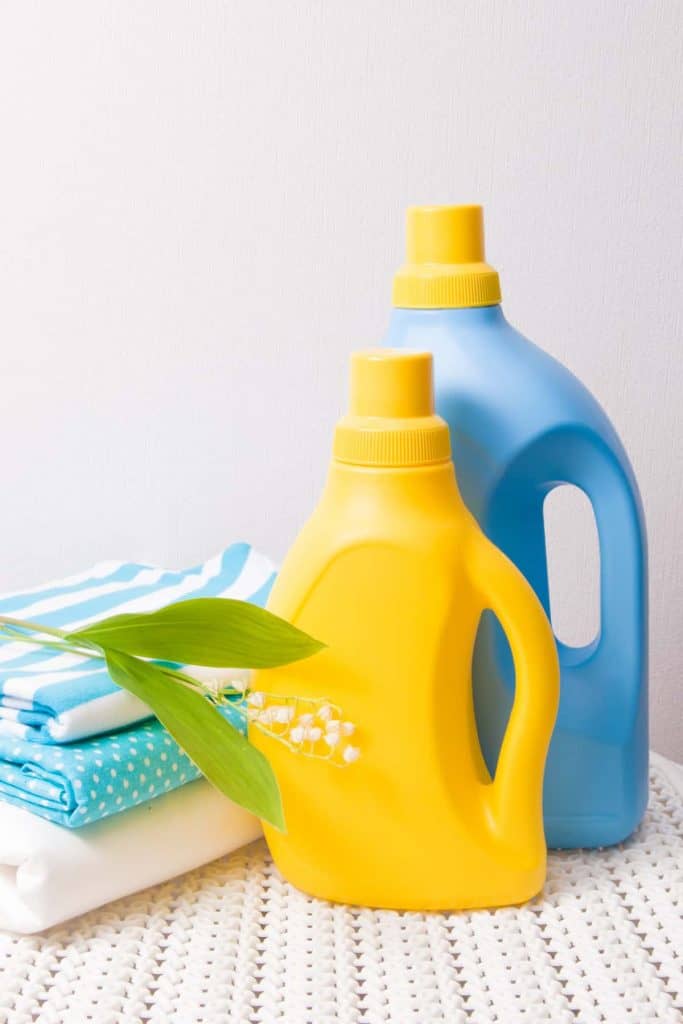
3 Reasons you should NOT put fabric softener in toilet tank
Add this cleaning hack to your list of things not to try at home. Here are three solid reasons to keep this laundry cleaner away from your toilet.
1. It may clog pipes
If you have tried this cleaning hack a couple of times, no worries, your toilet and plumbing should be fine. But, if you’re regularly putting fabric conditioner in toilet tank it could spell trouble for your pipes and plumbing system in the long run.
The same chemical cocktail that leaves a filmy residue on your clothing and the interior of your washer could also clog toilet components and pipes over time.
It’s important to remember that fabric conditioner or fabric softener in toilet tank is not completely water soluble. Part of each molecule is hydrophobic meaning it doesn’t mix with water.
Also, liquid softeners contain fatty petroleum or palm oil-based ingredients. These ingredients may contribute to the development of clogs.
Over time, this leads to a clogged water drain in washing machines, and a clogged toilet and pipes, if used frequently in toilet tanks.
Save yourself a hefty plumbing bill from a plumbing expert and avoid using this laundry cleaner to freshen up your throne!
2. Fabric softener is a no-no for septic systems
For those who have an onsite sewage system, stay clear of using fabric softeners altogether.
According to Purdue University, fabric softener (either from your toilet tank or laundry machine) appears on its “Dirty Dozen” list of products you should keep out of your onsite septic system.³
Fabric softener throws the balance off of an onsite septic system. It dissolves the sludge that accumulates along the bottom of the tank. This leads to a greater buildup of organic matter in the effluent (the middle layer, which is rich in organic matter).
This excess organic matter needs to be treated in the absorption field. However, the fabric softener creates a barrier along the sides of the absorption trench which prevents effluent from entering the field.³
The result? Early system failure.
If you have an onsite septic system, it’s especially important to watch what goes down the drain or flush toilet.
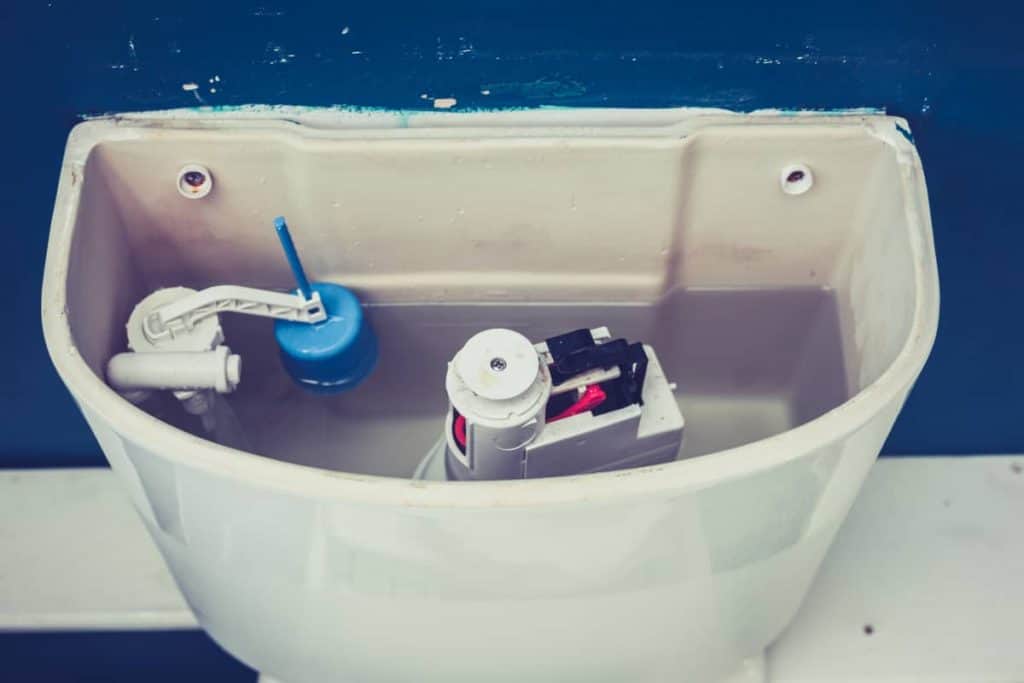
3. Liquid fabric softener harms the environment and your health
Anything you use in your household, from a bottle of fabric softener to other chemical liquid detergents, affects your health and the quality of indoor air. And anything that you flush down the toilet or drain eventually enters waterways and the environment.
According to the U.S. Environmental Working Group (EWG), it’s best to skip fabric softeners (both liquid and dryer sheets) altogether.⁴
The EWG lists the following ingredients as “red flags” for both personal health and the health of the environment:
- Quaternary ammonium compounds (aka “quats”): While quats make clothes feel softer, they are triggers for those with asthma and may harm the reproductive system.
- Synthetic fragrance: Manufacturers may list the term “fragrance” without disclosing what chemicals they actually used in the making of the scent. You’ll find phthalates (which infuses the scent) and galaxolide (which may accumulate in the body over time). The EWG estimates over 3,000 fragrance ingredients commonly found in household products—most of which we know little about. Those with eczema, allergies, and asthma may be more sensitive to fragranced products.
- Synthetic colors and preservatives: Similar to fragrances, artificial colorants and preservatives each consist of many chemical compounds. Of particular worry in softeners is methylisothiazolinone which is a skin irritant. Glutaral, another skin irritant, may also trigger asthma and is toxic to aquatic animals. A colorant called D&C violet 2 has links to cancer.⁴
About that cleaning hack using a bottle of Fabuloso in your toilet tank …
There was (yet) another viral video showing how someone punctured a bottle of Fabuloso (a multi-purpose cleaner) and tipped it into a toilet tank. The thinking was that the Fabuloso and its fragrances would slowly leak out into the tank and leave the toilet bowl clean and smelling like a bed of roses with each flush.
This is NOT recommended for a number of reasons. After scouring the internet, many plumbers profess that the chemicals in this hack may harm certain toilet components, in particular, the flush valve.
Secondly, Fabuloso is meant to be diluted. Tipping a concentrated cleaning fluid into the toilet tank provides more cleaning power than recommended, leading to quicker wear down of your toilet. This may cause costly plumbing fees down the road.
But you CAN use a bit of Fabuloso as a regular toilet bowl cleaner.
Other ways to keep your toilet smelling fresh
If your bathroom regularly smells like urine or mildew, masking the odor with chemical household cleaners won’t make it go away. Often, the source of the problem lies in a leak or poor ventilation. Sometimes, a deep clean of the bathroom is all that’s needed.
If you want to neutralize unpleasant odors and gently disinfect, there are simple and natural cleaners that really work: distilled white vinegar and baking soda.
Simply pour roughly 1 cup of white vinegar into the bowl and scrub with a toilet brush. To boost scrubbing power, a sprinkle of baking soda will create a fizzing chemical reaction with the vinegar to better help slough off hard water stains.
Let the baking soda and vinegar sit for about 30 minutes to work their magic. Then gently scrub away all toilet bowl stains.
To keep your toilet fresh with every flush, add ½ cup of white vinegar to the tank once a week. This helps keep the toilet running smoothly and gently disinfects at the same time.
And, don’t underestimate the simple task of regular cleaning. Giving toilet bowls a quick scrub at least once a week prevents unsightly toilet stains and hard mineral buildup.
Safety tip: Never mix bleach with vinegar when cleaning as this creates a toxic gas.
Possible reasons why your toilet is smelly
If you’re thinking of ways to keep your toilet from smelling bad, it’s best to tackle the root issue, rather than simply mask the odor with detergents and artificial fragrances. A clean, well-functioning commode should not smell.
If you do notice foul smells from the lavatory, here are a few possible issues to look for:
- Mildew or mold: Black, orange, or green rings in the toilet bowl are signs of mildew or mold growth. These forms of bacteria thrive in moist environments, so it’s not surprising they’ve found a home in the bathroom! It’s time to break out the protective gloves and disinfectant. Check out our guide to removing toilet bowl stains.
- Urine: Sometimes a good cleaning is all you really need to eradicate foul odors. Focus on the toilet seat, around the base of the bowl, and don’t forget to wash any toilet mats.
- Toilet leak: Have you noticed excess moisture coming from the base of the toilet? Water coming from under a toilet indicates a leak somewhere. Most commonly this could mean a crack in the bowl, or that you simply need a new wax seal.
Related questions
Can you put laundry detergent in a toilet tank?
No, it’s best to only use cleaners that are formulated for toilets. Liquid detergent or laundry detergent pods are designed for washers, not toilets.
Just as using a fabric softener in the toilet tank can clog pipes, the same applies to laundry detergent. Besides, it may create bubbles, and damage the toilet parts such as the rubber flapper.
Will laundry detergent unclog a toilet?
No, instead of using laundry detergent to clear stubborn clogs in the toilet trap, try liquid dish soap such as Dawn dish soap.
Dish soap along with hot water and a bit of plunging often does the trick!
Most toilet clogs are made of greasy or fatty molecules. And dish soap is great for removing grease buildup, whether on dishes or in toilets.
Read more about clearing toilet clogs with dish soap.
Will vinegar damage toilet bowls?
No, vinegar is safe to use on most porcelain bowls. While it’s a natural and gentle acid cleaner, it’s still milder than many other commercial acidic toilet cleaners. Check your manufacturer’s instructions for more details.
Can you put scent beads in the toilet tank?
Simply put, it’s not recommended to use scent beads in a toilet tank. Scent beads (also called laundry beads or scent boosters), are tiny capsules designed to go in washing machines to infuse a load of laundry with artificial aroma. They are designed to break down during the wash cycle leaving your clothes smelling wonderful.
That said, they are not designed for use in your toilet. Instead of disintegrating, they may simply clog up your toilet cistern, leaving you with a toilet that doesn’t flush, or gets backed up.
👉 If you like this post, see other Timeless Cleaning Tips You Need To Know. 🌟
Would you like more timeless tips via email?
Fun tips to help you live an independent, self-sustaining lifestyle. Opt-out at any time.


References
- American Cleaning Institute, Ingredients Glossary, https://www.cleaninginstitute.org/understanding-products/ingredients/ingredient-glossary. Accessed October 2023.
- University of Georgia Family & Consumer Sciences, Healthy Indoor Environments (March 2018), https://site.extension.uga.edu/hie/files/2021/08/Healthy_indoor_environments_newsletter_March_2018.pdf. Accessed October 2023.
- Purdue University, Keep the ‘Dirty Dozen’ Out of Your Onsite Sewage System (Septic Tank), https://www.extension.purdue.edu/extmedia/HENV/HENV-106-W.pdf. Accessed October 2023.
- Geller, Samara (05 May 2016). “Skip the Fabric Softeners,” U.S. Environmental Working Group (EWG). Accessed October 2023.

Author: Josh Tesolin
Josh is co-founder of RusticWise. When he’s not tinkering in the garden, or fixing something around the house, you can find him working on a vast array of random side projects.

